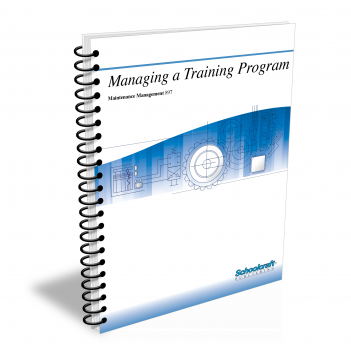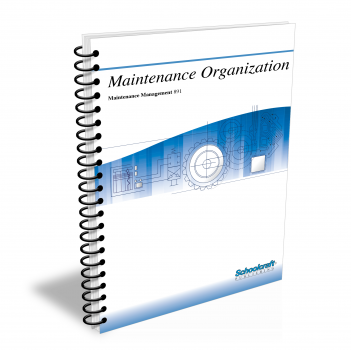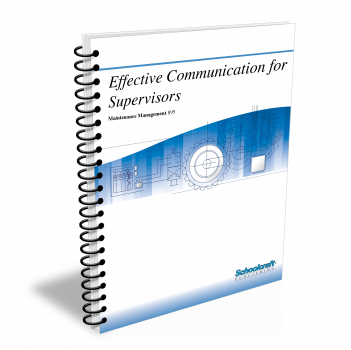Managing a Training Program

Course Number: 897
The Managing a Training Program textbook covers analysis of training needs. It describes various kinds of training and lists important steps in administering training. Compares group management techniques to self-study. Discusses the training environment. Examines how to keep training records and how to evaluate training results.
Does your curriculum require additional topics not included in this textbook? Build a customized version of the Managing a Training Program textbook below.
Recommended Contact Hours – 10
Preview a Chapter
Available Supporting Material
- Table of Contents
- My Custom Book
- Exam Copies
- Suggested Titles
Table of Contents
Chapter 1: Analyzing Your Training Needs
Topics: Reasons for training; Why people want to be trained; Your training attitude; What is training?; Kinds of training; Front-end analysis; Written performance objectives; Making sure training works
Learning Objectives:
- Define training and state the main reason for training today.
- Explain the problems involved with trial-and-error learning.
- List three important steps in administering training.
- Explain why good communication is important in training.
- Name three distinct kinds of training.
- Explain the steps involved in a front-end analysis.
- Tell why it is important to write performance objectives.
Chapter 2: The Supervisor as Trainer
Topics: Training situations; Self-paced training; Group-paced training; The environment; Starting out; Keeping them with you; Supervised self-study; The level of training material; Developing your own training programs; Using commercially prepared training packages
Learning Objectives:
- List the advantages, disadvantages, and applications of self-paced and group-paced training.
- Lists several important aspects of the training environment and tell why each is important.
- Explain several group management techniques.
- Name at least three advantages of supervised self-study.
- Explain the importance of determining the level of your training needs.
- Evaluate the suitability of commercially prepared training programs.
Chapter 3: Using Training Media
Topics: Introduction to training media; Lecture; Lecture with visual aids; Computer slide shows; Training with DVDs and videotapes; Manuals; Programmed instruction; Computer-based training
Learning Objectives:
- List at least six factors that influence the usefulness of a training medium.
- Name several types of visual aids and explain how each can be used to improve a lecture.
- Explain how to put together a useful sample set.
- Trace the steps involved in the making of a computerized slide show.
- List several advantages of videotapes over films.
- List the advantages of DVDs over videotapes.
- Give the main reason programmed instruction is effective.
- Describe the usefulness of computers in training.
Chapter 4: Teaching and Evaluating Success
Topics: Twelve rules for adult learners; Before class starts; Ensuring you reach trainees; Points to keep in mind; Making training relatable; What these rules mean; Record keeping and data collection; Types of records to keep; Time standards; Evaluating training; Pretest/post-test; Writing tests; On-the-job observation; Questionnaires; Record keeping and evaluation
Learning Objectives:
- List several reasons for keeping training records.
- Name the three types of training records that are important to keep.
- Explain how time standards are established and how they can be used to measure performance.
- Name three common training evaluation methods and explain the applications of each.
- Give examples of five types of written test questions and give advantages and disadvantages of each type.
- Tell why an on-the-job observation checklist is an important evaluative tool.
- Describe the purpose of a questionnaire.
Add Chapters to Your Custom Book
Select Chapter(s):
- Chapter 1: Analyzing Your Training Needs
- Chapter 2: The Supervisor as Trainer
- Chapter 3: Using Training Media
- Chapter 4: Teaching and Evaluating Success
My Custom Book
Create a custom book that contains only the training content that your students need to succeed
Our topics cover a broad and diverse spectrum of subject matter, from reading blueprints to electrical schematics, measurement to rigging and safety, material handling to welding, and everything in between! Choose only the lessons that meet your specific curriculum requirements.
Request Exam Copies
Exam Copies
Ready to see a copy of our textbooks? After selecting which textbooks you’d like to review for your course, you can submit your request by either logging in or creating an account so we know where to ship your exam copies. A representative from Schoolcraft will contact you to confirm and finish processing your request.
Exam copies are always free and yours to keep.
Selected Exam Copies
none selected
* Maximum of five copies can be ordered




